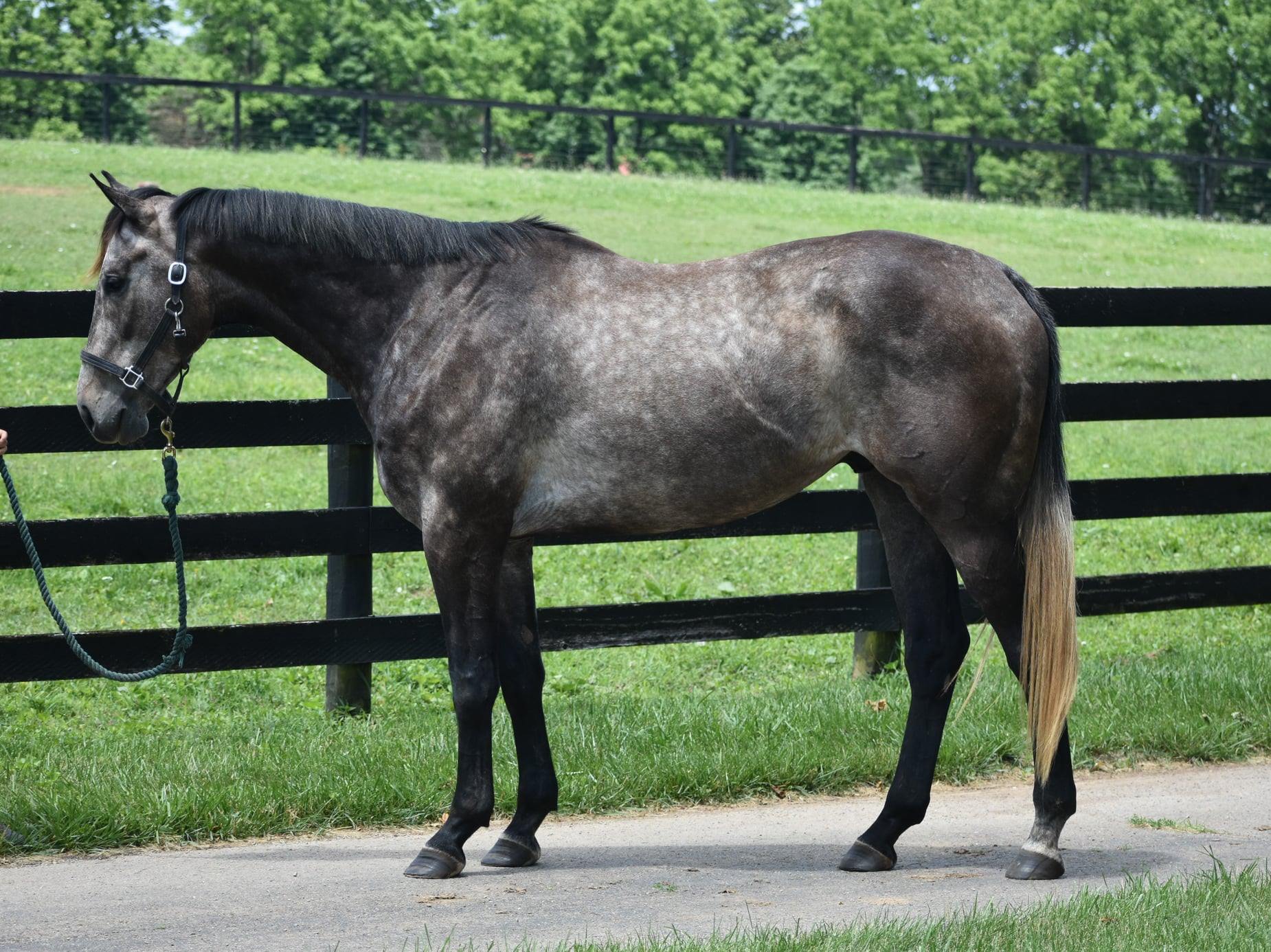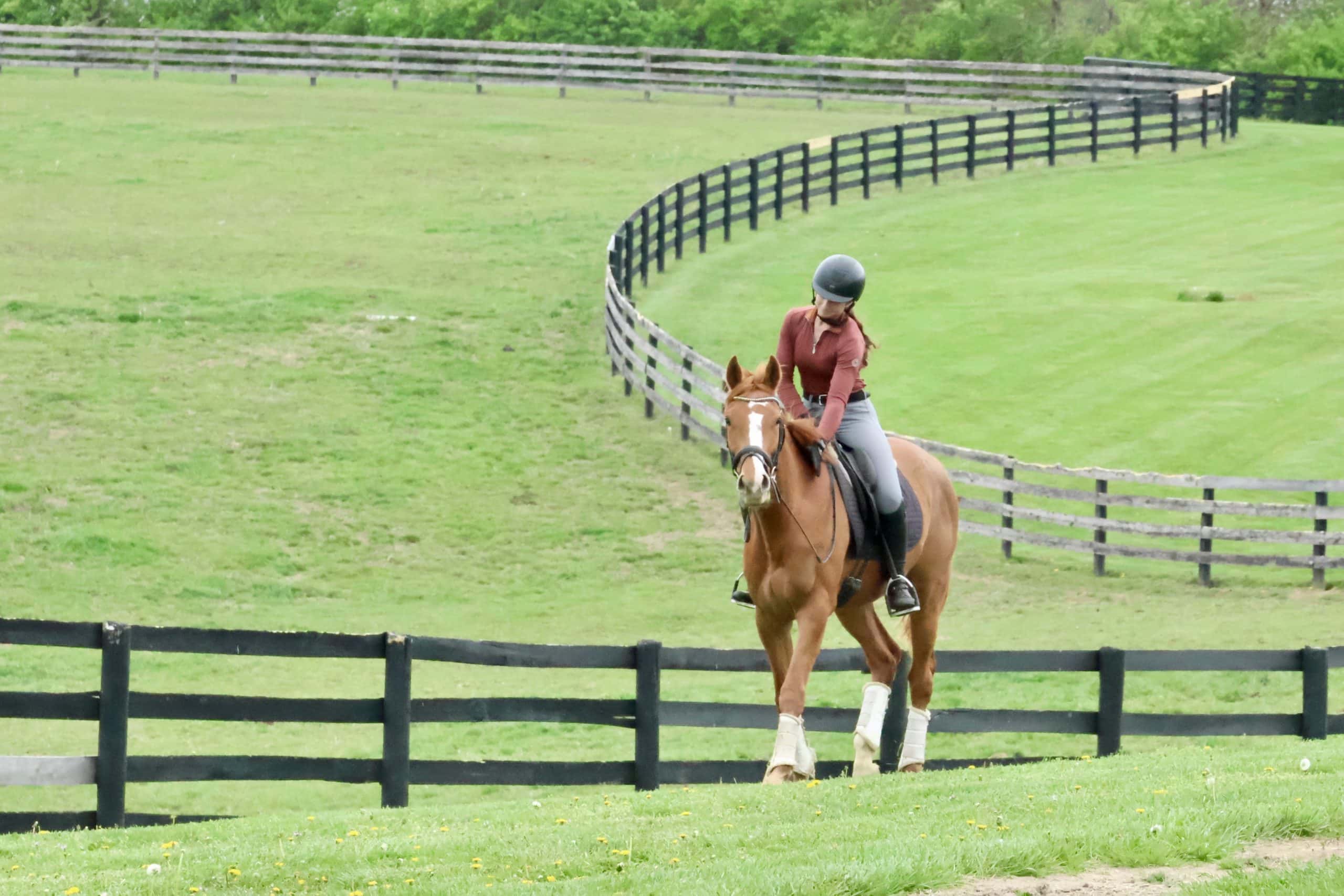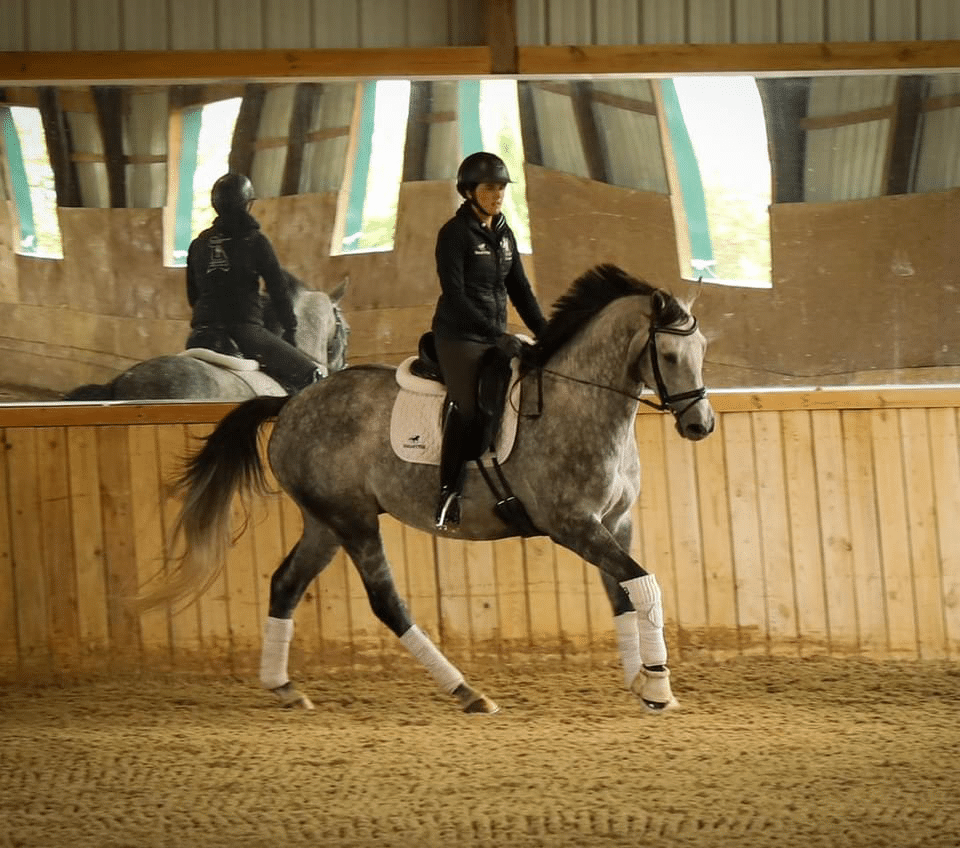Producing any horse in training, especially a Thoroughbred, is a remarkable investment of time, energy, and resources – and the work doesn’t stop when it’s time to sell that horse to its next home. Selling the transitioned Thoroughbred, whether that horse is still developing or is considered more finished, is a bit of a different process than selling prospects right off the track: we consulted two experienced sellers to learn more.
Emily Brollier Curtis of Miramonte Equine, based in Nicholasville, KY, specializes in dressage with a lesson, training and sales program. Brollier Curtis has developed 15 horses (and counting) to the FEI level, and earned her USDF Bronze, Silver and Gold Medals with her first starting and training project she acquired at the age of 14. While Brollier Curtis works with all breeds, she has a particular talent and passion for working with Thoroughbreds, regularly competing at the Thoroughbred Makeover and selling her graduates to continue their careers with new riders.
Lindsay Gilbert of Transitions Sport Horses, based in Lexington, KY, has experience selling and producing a wide range of horses, getting her start with reselling lightly-started Thoroughbred prospects that had been off the track from 30 to 90 days. She then worked as the manager of the Young Horse Development Program at Spy Coast Farm for two years, working with everything from unstarted young horses to FEI jumpers. Now working with her personal business, she specializes in developing and selling transitioned Thoroughbreds and other sport horses, typically in her program six to 12 months with some show experience under their belts.
Creating a Listing
Both sellers heavily utilize social media to get their listings in front of buyers while also maintaining their own websites. Gilbert keeps her sales horses catalogued on her site but uses social media as the primary listing; Brollier Curtis uses her social media listings to drive traffic to her website.
To reduce basic questions from horse shoppers, which saves time in the long run, both sellers include pertinent information in their social media posts: name, bloodline information, age, height, breed, sex and location.
From there, each seller has found a basic formula that works well for them: Gilbert adds two or three brief paragraphs of additional information, covering the horse’s training level, his personality, what she feels he’s best suited for, and any limitations for use. “I keep it short and sweet,” she adds.
Brollier Curtis typically titles her posts, highlighting the best traits of the horse. “My ads open with something like ‘Adult Amateur & Junior Friendly,’” she describes. “Then I’ll add something about his training, like ‘with easy flying changes’ or ‘super brave,’ and then finish with a key phrase, like ‘beautiful black beauty’ or something else interesting.” All of her listings include a link back to her website where she maintains more detailed listings, plus utilizes built-in analytic tools to look at when her site is most active and details on demographics of her shoppers.

Both sellers include pertinent information in their social media posts: name, bloodline information, age, height, breed, sex and location. Photo courtesy Lindsay Gilbert
Photos & Videos
While their individual techniques to list horses may differ slightly, both Brollier Curtis and Gilbert agree on a fundamental truth about marketing horses for sale: good photos sell horses. To that end, both sellers focus a lot of attention and energy on getting good-quality photography of their horses for sale. Gilbert often pays a professional photographer to come to her farm to capture images, as well as purchases show photography for top-notch action photos; Brollier Curtis invested in professional-grade camera equipment and learned how to use it, taking literally thousands of photos of each horse in her program to winnow down to a handful of sale-worthy shots.
“Show buyers that you care,” adds Gilbert. “Don’t just use screenshots off your phone.” Brollier Curtis agrees: “Stop using screenshots of videos, please! They’re rarely clear enough to show the horse well.”
Both sellers also gather conformation photos in addition to eyecatching action shots (see our guide on conformation photos). Gilbert includes conformation photos with her listings, calling them “indispensable;” Brollier Curtis typically keeps them handy but doesn’t always use them with her listings unless the horse has a top-notch build. “Everyone has an objective opinion on the conformation they like,” she describes. “So I have them only if people ask for them.”
Once the perfect attention-grabbing photos are selected, both of our sellers then use video to show the horse in motion and his level of training. “I keep videos under three minutes,” describes Gilbert. “No one wants to sit there and watch five minutes of trotting around and around – I use a video editor to put clips together and show all three gaits, transitions and the important skills for the horse’s experience level.” Those important skills might range from putting together a full course to toting around Gilbert’s five-year-old daughter to demonstrate a horse’s good mind.

Brollier Curtis likes to include photos that illustrate something special about a horse, such as being amateur- or junior-friendly. Photo courtesy Emily Brollier Curtis
Pricing Horses & Screening Buyers
There’s no set formula for pricing horses – but there are a few tricks that will help make this process easier. “My business degree answer is that the market will tell you,” says Gilbert. “If you have no interest but you’ve done everything well with your ads, your horse is probably overpriced. On the flip side, if your inbox is flooded with messages about a horse, you may be priced lower than market value.” She advises looking at other listings to see where other sellers are pricing horses that are at a similar level of training and experience – but to take those prices with a grain of salt, as you never know why other sellers may be pricing their horses that way.
“It’s your prerogative to price high,” adds Gilbert. “But you might hold that horse a little longer as a result. If you can afford to do that, you can wait for the perfect buyer.”
Brollier Curtis thinks of pricing as a sliding scale: “I look at a horse and say, okay, this horse would be at ‘X’ price if he were perfect, but then I adjust down with vices, blemishes, or challenges.” She uses as an example her most recent Makeover graduate: a lovely big-bodied horse who was schooling first level at four years old and priced in the $25,000-$30,000 range. A vetting revealed bone chips, and he ultimately sold for $15,000 to a well-matched home after the chips were surgically removed.
Gilbert factors in a little bit of wiggle room in her pricing, giving herself 10-15% for buyers to negotiate. “People want to feel like they’re getting a deal,” she describes. “And they tend to know what their budget is when they start looking – if you price too high, they’re not going to reach out. I think of pricing in brackets: mid four figure, upper fours/low fives, mid fives, and so on. You don’t want to price up into that next bracket with your wiggle room, or you’re going to lose your target buyers.”
When screening buyers, Brollier Curtis remembers that time is money, but that time invested wisely can return big dividends. “I’m always willing to answer a lot of questions, because that helps screen buyers – I can get a read on people and help them figure out what it is that they really want or need,” she describes. “I also give buyers a free lesson when they come to try a horse – that helps protect everyone, including the horse, the buyer, and me as the seller.”

Emily Brollier Curtis gives a free lesson when buyers come to try a horse, which protects all parties: buyer, seller, and most importantly, the horse. Photo courtesy Emily Brollier Curtis
Honesty Is The Best Policy
While “honesty is the best policy” usually goes without explanation, there are a few interpretations as this idiom applies to selling horses that are worth mentioning. “Be as honest as possible,” describes Gilbert. “The last thing I want to do is come across as trying to hide things – that’s both for my reputation, but also for the sake of the horse.”
This applies not only to writing an accurate listing and presenting horses honestly and accurately to potential buyers, but in the actual composition of listings as well. “Always back up what you say in the ad with visual marketing,” says Gilbert. “If I say a horse is a Training level packer, then I need to have video footage of the horse going around Training. You need to illustrate your written ad with matching visuals for your buyers.”
Brollier Curtis agrees. “Word choice is really important when writing ad copy,” she describes. “My job when writing a listing is to showcase the horse, but also to back up what I say.” This applies to describing a horse’s potential as well: “If I say a horse has ‘Grand Prix potential,’ then I need to be prepared to explain to buyers what that means.”
She also extends this to a horse’s potential for other disciplines. “I sell dressage horses: if I have a horse that I think might have more potential in eventing, I send him to an eventing trainer. I don’t try to market that potential myself. That’s a common sense thing, because my business model and specificity in dressage horses is so successful for me.”

“You need to illustrate your written ad with matching visuals for your buyers,” says Gilbert. Photo courtesy Lindsay Gilbert
Take-Home Message
Gilbert and Brollier Curtis agree: there is a buyer for every horse, and their job in sales is to find the best situation that will benefit all parties. Selling the transitioned Thoroughbred can be a challenging process, but when done well to showcase the time, energy and resources that have developed that horse into a buyer’s next partner, that process can be rewarding too.

